The Role of Liquid Chromatography–Mass Spectrometry in the Characterization of Therapeutic Monoclonal Antibodies
Special Issues
A review of the central role LC–MS plays in characterizing mAbs and biosimilars, including highlights of top-down and middle-up approaches to measure the intact masses of mAbs and their subunits, the current state of peptide mapping techniques, and glycoprofiling methods.
Monoclonal antibodies (mAbs) have been increasingly used as biotherapeutic agents, and a number of new mAbs are currently in the drug pipeline. Over the next five years the patent on at least nine major biotherapeutic mAbs will expire, opening the door for development and marketing of generic forms known as biosimilars. This article reviews the central role mass spectrometry (MS) coupled to liquid chromatography (LC) plays in characterizing these antibodies. Contemporary top-down and middle-up approaches using MS and various novel separation techniques to measure the intact masses of mAbs and their subunits or domains are highlighted. Example data of an innovator mAb, adalimumab, are presented that show the identities and relative abundances of the isoforms associated with this mAb. Similarly, the current state of classical peptide mapping using reversed-phase LC and tandem MS with scan-dependent acquisition is briefly reviewed. Novel approaches that speed up analysis and provide information on post-translational modifications, glycosylation, and disulfide mapping are discussed. Example data of stressed and unstressed samples of adalimumab are also presented to demonstrate peptide mapping and modifications to the antibody. Lastly, the current use of MS in glycoprofiling of mAbs is reviewed. Example glycan data for adalimumab generated by a novel labeling scheme and sensitive to detection by both fluorescence and MS are presented.
The use of the monoclonal antibodies (mAbs) as biotherapeutic agents has been rapidly increasingly over the last decade, and mAbs or related forms are currently replacing many small-molecule drugs. As of this year, approximately 30 mAbs are approved and marketed in Europe and the United States (1). Last year, nine out of the 45 drugs approved by the Food and Drug Administration (FDA) for use in the United States were mAbs (2). Another large targeted market is that of biosimilars, which are bioengineered imitations of the innovator biotherapeutic. Over the next four years the patent will be expiring on nine major innovator drugs, totaling nearly $30 billion in sales during 2014. The most lucrative of these, adalimumab (Humira), is eligible to become a biosimilar in 2016 (3).
Human immunoglobulins are a class of glycoproteins that have similar structures and functions and are composed of 82–96% protein and 4–18% carbohydrates or glycans. Human immunoglobulin G (IgG) is the most abundant antibody in the blood and has four subclasses, IgG1 through IgG4, whose differences are defined by the amino acid sequence in the hinge region and the number of disulfide bonds in this region (4). Adalimumab is an IgG1 recombinant mAb that targets tumor necrosis factor (TNF). As can be observed in Figure 1, adalimumab, like the other IgG counterparts, has two heavy chains and two light chains held together by four interchain disulfide bonds. It is made up of 1330 amino acids, giving it a molecular mass of approximately 150 kDa. This mAb also has 12 intrachain disulfide bonds that form loop structures in the variable and constant regions of the light and heavy chains. The variable regions at the N-terminal end of the light and heavy chains (VL and VH, respectively) show the most variation in the amino acid sequence and are responsible for antigen binding. Within these variable regions near the N-terminal end of the light and heavy chains are the complementarity determining regions (CDR). Each antibody has a total of 12 with three CDRs per chain. The CDRs are part of the variable chains in immunoglobulins (antibodies) and show the most variability and are crucial to the diversity of antigen specificities. The N-terminal tails of the mAb are referred to as the Fab or fragment antibody region. The Fc or fragment crystallizable portions (C-terminal ends) are responsible for biological properties such as binding to cell membranes and placental transfer. In this Fc region N-linked glycosylation occurs on the heavy chains, and for adalimumab this occurs at asparagine 301.
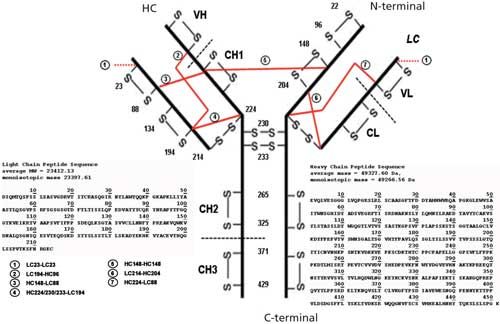
Figure 1: Diagram of adalimumab; LC = light chain, HC = heavy chain, VL = variable light chain, VH = variable heavy chain, CH = constant region heavy chain, CL = constant region light chain, S-S = normal disulfide bridges with numbered cysteines. Also shown in red are disulfide bond scrambling observed in stressed adalimumab.
Mass spectrometry combined with liquid chromatography (LC–MS) has been integral in the structural characterization of these complex mAb structures. Proteins readily ionize under atmospheric pressure electrospray ionization (APESI) and form multiple charged ions, allowing even the intact mAb to fall within the scanning range of most modern mass spectrometers. Modern high-resolution mass spectrometers allow for mass analysis of the intact mAb and subunits and, when equipped with dissociation techniques, permit top-down or middle-down analysis of the fragmented molecule.
Tandem mass spectrometry when accompanied with highly resolving separations such as reversed-phase ultrahigh-pressure liquid chromatography (UHPLC–MS-MS) or capillary electrophoresis (CE–MS-MS) allows for a bottom-up approach to protein characterization, which leads to amino acid sequence verification, mapping of disulfide linkages, glycopeptide profiling, and identification of post-translational modifications (PTMs). MS can be very useful in identifying and elucidating the structure of N-linked glycans and also in locating the sites for glycosylation. This article reviews the current role of MS in the characterization of large proteins and presents data for adalimumab to provide examples of the use of MS in intact mass analysis, in a middle-up approach for mass analysis, peptide mapping, and, finally N-linked glycan profiling.
Experimental
Materials
Adalimumab was obtained as an injectable 50-mg/mL solution (Humira from AbbieVie Inc.).
Sample Preparation
For photo-induced stress, 100 µL of a 10-mg/mL solution consisting of adalimumab diluted with water in a clear glass autosampler vial was placed under a xenon lamp at 765-W/m2 intensity for 24-h. For heat stress, adalimumab diluted with water to 10 mg/mL was incubated for 6 weeks at 40 °C and aliquots were taken at 2, 4, and 6 weeks for analysis. Adalimumab stressed at an elevated pH and temperature was diluted to 10 mg/mL in phosphate buffer (pH 9) and incubated for 48 h at 40 °C.
Intact Mass and Subunit Analysis
For intact mass analysis, adalimumab was diluted to a concentration of 2 mg/mL with deionized water before analysis. To obtain light and heavy chains, adalimumab was diluted to 2 mg/mL with deionized water, denatured with 7 M guanidine hydrochloride, and reduced with TCEP.
Proteolytic cleavage of the adalimumab was accomplished with IdeS enzyme to produce the Fd and Fc domains of the heavy chain. The protein was then denatured with 7 M guanidine HCl and reduced with dithiothreitol (DTT).
Peptide Mapping
Adalimumab was digested with the endoproteinases Lys-C and trypsin using two methods. The first was the filter aided sample preparation (FASP) technique (5).
In the second approach used for the stressed samples, 200 µg of protein was denatured with 6 M guanidine hydrochloride and reduced with DTT. After the samples were alkylated with iodoacetamide, and diluted with water, the solutions were digested overnight with Lys-C.
N-linked Glycans
Adalimumab glycan preparation was done with a Waters GlycoWorks RapiFluor-MS N-Glycan labeling protocol as described by Lauber and colleagues (6,7). Briefly, samples were denatured at 90 °C for 3 min with the Rapigest surfactant and deglycosylated with the enzyme Rapid PNGase F at 50 °C for 5 min. Sample solutions were then cleaned up using hydrophilic-interaction chromatography (HILIC) solid-phase extraction (SPE).
Instrumental Conditions
Intact and Subunit Mass Analysis
A reversed-phase separation was performed on a diphenyl column (100 mm x 2.1 mm, 3.5-µm dp Agilent AdvanceBio RP-mAb) using water (mobile-phase A) and an 80:20 (v/v) mixture of n-propanol and acetonitrile (mobile-phase B) with each containing 0.05% (v/v) trifluoroacetic acid. The flow was 0.2 mL/min, and the column temperature was maintained at 80 °C. The gradient was adjusted to allow separation of the intact mAb and subunit peaks. Injection volumes of 5–10 µL were used.
Mass analysis was performed using a Waters Xevo G2 time-of-flight mass spectrometer connected to a Waters Acquity H-Class UPLC system. The electrospray source was operated under the following conditions: capillary voltage, 3.0 kV; cone voltage, 40 V (intact and reduced mAb) and 25 V (three-part subunit); drying gas, 1200 L/H; cone gas, 50 L/H; desolvation temperature, 350 °C; and source temperature, 140 °C. The collision energy was set at 6 V and the mass spectrometer was operated in sensitivity mode (resolution approximately 10,000–15,000). Scanning was performed across m/z 500 to 4000 in 1 s.
Peptide Mapping
A Waters Acquity UPLC system interfaced with a Thermo Orbitrap LTQ-XL mass spectrometer was calibrated and tuned for maximum peptide response using angiotensin. A 150 mm x 2.1 mm, 2.5-µm dp Waters X-Select Peptide CSH XP column set at 60 °C was used for the reversed-phase peptide separation. The ultraviolet (UV) absorbance was monitored at 214 nm.
Peptides were separated at 0.2 mL/min flow rate with mobile-phase A as water with 0.05% trifluoroacetic acid and mobile-phase B as acetonitrile with 0.05% trifluoroacetic acid. The gradient was started and held at 3% organic for 3 min and ramped to 50% over 47 min before column rinsing and reequilibration. The mass spectrometer was set to scan at a resolution of 30,000 over the mass range m/z 200–2000. Using scan-dependent acquisition and collision-induced dissociation (CID), daughter ion scans were acquired for the top four ions found in each scan.
N-linked Glycans
The HILIC-UHPLC separation was accomplished by using a 150 mm x 2.1 mm, 1.7-μm dp Waters Acquity UPLC Glycan BEH Amide column (130 Å). Mobile-phase A was 50 mM ammonium formate (pH 4.4) and mobile-phase B was acetonitrile. The column temperature was set to 60 °C. A shallow gradient slowly decreasing the composition of mobile-phase B over 50 min was used to separate the labeled glycans. The fluorescence wavelengths were set to 265 nm for excitation and 425 nm for emission.
Mass spectra were acquired over a scan range of m/z 300–2000 using an Orbitrap LTQ mass spectrometer set at 7500 mass resolution. Data-dependent daughter ion scans based on the top three ions found in each FT-MS scan were acquired on the ion trap.
Results and Discussion
Intact Mass Analysis, Top-Down Analysis, and Middle-Up Analysis
In a top-down approach, the intact mAb is introduced into the mass spectrometer and fragmented using a dissociation technique such as electron transfer dissociation (ETD). In a middle-down approach, the intact mAb is usually cleaved with an enzyme and the smaller middle-size pieces are introduced into the mass spectrometer and fragmented using ETD or a similar dissociation technique. In the middle-up approach, the intact mAb is again cleaved into pieces using an enzyme, but instead of dissociating the pieces, mass analysis is performed to elucidate the isoforms of the mid-sized pieces of the mAb.
Conventionally used bottom-up MS strategies can provide most of the amino acid sequence coverage. However, it has been demonstrated that multistep, time-consuming sample manipulation can result in artifactual PTMs such as deamidation and oxidation (8,9). P. Hao and colleagues (10) discussed deamidation associated with PNGase F treatment to remove glycans, various buffers, and the need for proper chromatographic resolution of isotopes. J.F. Froelich and colleagues (11) considered the origin and control of oxidative peptide modifications.
Currently, it is possible to use a top-down approach that will not add artifactual PTMs and will bypass lengthy digestion steps, to analyze large intact proteins. Modern instruments, such as high-resolution Fourier transform ion cyclotron resonance (FT-ICR) mass spectrometers and some of the newer orbital ion trap Fourier transform mass spectrometers, are capable of separating isotopic clusters of multiply charged proteins. The introduction of additional modern fragmentation techniques over the conventional collision-assisted disassociation (CAD) or collision-induced dissociation (CID)-such as high-energy collision-dissociation (HCD), ETD, and electron-capture dissociation (ECD) (12,13)-has allowed for structural characterization of larger proteins while preserving PTMs (14,15). This top-down approach is beneficial for pharmaceutical analysis because of a significant reduction of sample preparation time and related artifacts (16–19). Mao and colleagues (20) used a Fourier transfer-ion cyclotron resonance (FT-ICR) MS system with a 9.4-T magnet to obtain unit resolution across the isotopic envelope of a IgG1 mAb, thereby establishing a new upper mass record for unit mass baseline resolution of proteins. After the intact mAb was fragmented by ETD, sequence coverages of 30–40% were achieved across the light and heavy chain. Fragmentation of intact proteins with HCD and ETD allows for verifying protein sequences, but with significantly lower sequence coverage compared to the classical bottom-up MS approach (20,21). It has been shown that disulfide bonds can protect intact proteins from fragmentation, resulting in less sequence coverage (22). Detection of low-mass-difference PTMs like deamidation also can be difficult in top-down approaches during the analysis of intact proteins and requires chromatographic resolution of the native and deamidated isoforms of the protein.
Cleavage of the protein into large-sized peptides can improve amino acid sequence coverage compared to traditional bottom-up techniques and is referred to as an extended bottom-up proteomics approach (23). Proteolysis of the intact protein into smaller pieces before analysis in the mass spectrometer, now called a middle-down approach, reduces protein complexity and simplifies the isotopic distribution (24). Partial control of protein cleavage for middle-up and middle-down MS analysis also enhances total peptide coverage. It was proposed to use limited digestion to control protein fragmentation. Papain digestion was shown to cleave the antibody in the hinge region, which simplifies mass spectral analysis of the antibody domains to reveal the modification profiles of these variants with high mass accuracy and resolution (25). Limited digestion of antibodies with Lys-C can also generate free Fab and Fc fragments (15). However, the specificity of such limited digestion is very difficult to control. The immunoglobulin degrading enzyme, IdeS, cleaves the heavy chain of the antibody into specific fragments below the hinge region and after reduction results in two heavy chain domains (scFc or Fc/2 and Fd) and the light chains. This can assist for in-depth glycan analysis of the antibody (26,27). Recently, minimal sample preparation techniques were used with the help of membrane or micro column immobilized digestion enzymes. In this novel approach an in-line membrane was used for denaturing, reducing, and generating smaller protein fragments from a mAb before analysis using MS (28). A similar digestion and in-line analysis was performed using a micro column containing immobilized aspergillopepsin I (29). This technique required less than 10 min of preparation time and resulted in a mixture of peptides ranging in size from 3 kDa to 15 kDa. The middle-down MS approach of analyzing smaller protein fragments after digestion improves the fragmentation observed in MS2 spectra and can provide nearly complete sequence coverage (30,31).
Recent advances in ion fragmentation have improved the capabilities of top-down and middle-down MS analysis. Each of these different types of fragmentation has advantages and disadvantages. For example, traditional CID cleaves the peptide amide bond forming b and y ions; however, it readily fragments any glycosylation on a peptide and does not reveal the b and y ions. Both ECD and ETD produce nonspecific cleavage of the N-C backbone giving c and z ions and leaving the glycan relatively unbroken. Different types of ion dissociation differ in their cleavage of disulfide bonds. It has been shown that ECD and ETD cleave disulfide bonds better than CID and improve sequence coverage of disulfide bond–protected regions when using a top-down MS approach (30,31). Importantly, middle-size protein fragments are beneficial for traditional data-dependent fragmentation when optimized for +2 or +3 charges. Sequence coverage of approximately 50% was demonstrated for middle-down analysis of an antibody after IdeS digestion. The amino acid sequence coverage increased to 70% when the ETD fragmentation was optimized and additional averaging of MS data for distinct LC-MS runs was allowed (26).
Combinations of different types of fragmentation can be advantageous for a top-down approach. Because ETD is sensitive to charge density, the combination of EDT and CID can be beneficial for ion fragmentation (32). When the combination of ETD and CID was used for the analysis of glycopeptides, CID provided limited peptide bond information but showed the glycan fragmentation while ETD showed the peptide bond fragmentation and was used for the assignment of glycosylation sites (33). Recently, it has been shown that ETD in top-down MS analysis of intact therapeutic antibodies (Herceptin) when in combination with hydrogen–deuterium exchange can provide fast comparative evaluation of the higher order structure of antibodies (34).
Here mass analysis was performed on adalimumab and middle-up approaches were applied to the reduced subunits and IdeS-digested adalimumab. Figure 2 shows example total ion current (TIC) chromatograms of the intact mAb, the reduced subunits, and the light chain and domains of the heavy chain after IdeS digestion. The light and heavy chains were obtained by denaturing and reducing the mAb with TCEP. Adalimumab was also digested with the IdeS enzyme, which cleaves both heavy chains below the hinge region of the mAb after the glycine (G) amino acid at position 240 from the N-terminus of the heavy chain. These two cleavages result in the release of two single chain Fc (scFc) fragments (H241–450/451) of the mAb. Both variable regions of the heavy chain (H 1-240) and the light chain are still linked by the disulfide bonds and the two scFc domains (H241–450/451) still contain intramolecular disulfide bonds. After reduction of all disulfide bonds, two light chain subunits (L 1-214), two heavy chain fragments containing the variable regions (1-240), and two scFc constant regions of the heavy chains (H 241–450/451) are produced. Because these pairs are isobaric, three major subunit-domain peaks labeled as the light chain, the scFc (constant region of heavy chain), and Fd’ (heavy chain with both the variable region and a segment of the constant region) appear in the bottom chromatogram shown in Figure 2.
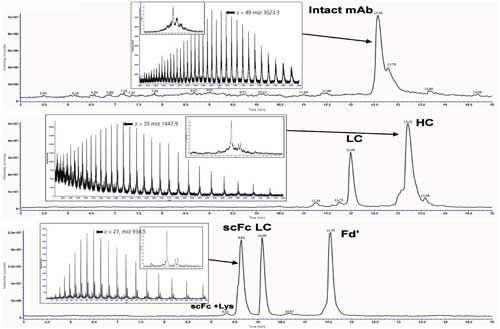
Figure 2: Total ion current chromatograms of adalimumab (intact mAb, light and heavy chains, and three-part subunit-domains from IdeS digestion). Electrospray spectra are presented with zoomed in view of maximum charge envelope.
The TIC chromatograms were produced by a reversed-phase separation with slight variations to the slope of the gradient to maximize separation in each case. For mass analysis on the intact mAb or the subunits–domains, the separation provides a means of introducing the mAb into the electrospray source free of salts or surfactants. A conventional reversed-phase separation as presented here in Figure 2 can be used or, if fast analysis is required, a rapid desalting reversed-phase separation employing a short polymeric column can be used. Size-exclusion chromatography (SEC) has also been successfully used to separate mAbs before analysis by MS. In recent years novel SEC columns with sub-2-µm particles suitable for UHPLC have recently been introduced for large biomolecules and are commercially available. Direct infusion can be used but nonvolatile buffer salts and surfactants must be removed using an off-line cleanup.
If these columns are used with MS, mobile phases containing a small amount of trifluoroacetic acid, formic acid, or another volatile buffer are commonly used. Harsh chromatographic conditions may preclude introduction of the mAb in its native form into the mass spectrometer and may even break up any aggregation that is normally occurring. The electrospray spectrum of intact adalimumab shown in Figure 2 has an ion with a charge of z = 49 in the center of the ionic envelope. This charge packet is enhanced to show finer details of the spectrum, which are limited by the sensitivity and resolution of the mass spectrometer. Smaller ions of the same charge associated with lesser abundant isoforms can be observed surrounding the major ion. Deconvolution of the electrospray spectrum using the maximum entropy (MaxEnt) algorithm, produced the spectrum of the intact mAb shown in Figure 3a. The major glycoforms have been identified by the mass assignment of the observed peaks in the spectrum based on their theoretical average molecular masses. In the intact mAb, both heavy chains contribute to the isoforms that are observed and, if the mAb is heavy glycosylated, produce a complex deconvoluted spectrum that can be difficult to interpret. Data mining can be extremely tedious. Similarly, clipping of the C-terminal lysine is apparent in the intact spectrum. Further modifications of the mAb at this elevated view might include the formation of pyroglutamate from N-terminal glutamine (-17 Da), the formation of trisulfide bonds (+32 Da) (35), the formation of thioethers (-32 Da) (36), cysteinylation (+119 Da), and glutathionylation (+305 Da) to name a few. Table I summarizes the observed masses of the isoforms in the intact mAb. Mass accuracy of course will depend on the quality of the mass spectrometer, calibration, and resolution that can be achieved. The time-of-flight (TOF)-MS used in this experiment can achieve mass accuracies of less than 10 ppm for major isoforms and less than 25 to 50 ppm for minor and trace isoforms.
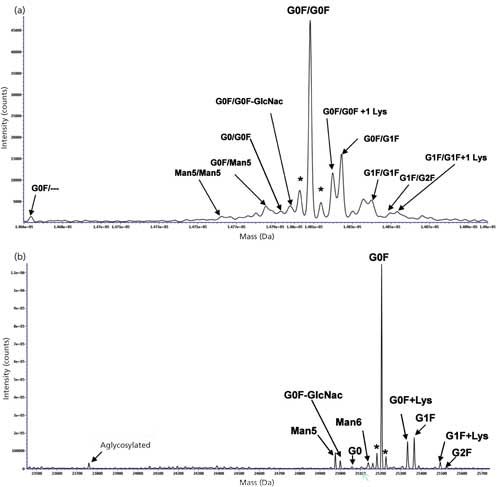
Figure 3: Comparison of deconvoluted mass spectra of (a) intact adalimumab and (b) scFc domain of the heavy chain showing the major identified isoforms (*artifacts associated with deconvolution).
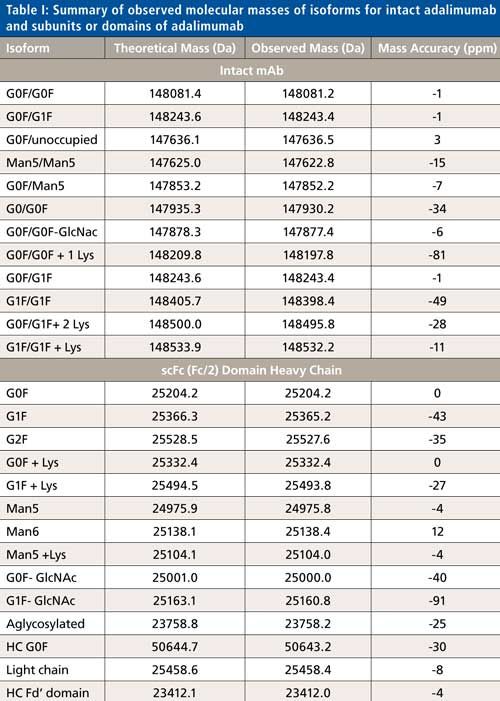
The deconvoluted spectrum of the scFc domain of the heavy chain is also shown in Figure 3. This spectrum was produced by averaging the electrospray spectra across the baseline to include both the main scFc peak and the smaller scFc + Lys peak labeled in Figure 2. The addition of Lys to the C-terminal end decreases hydrophobicity of the scFc domain and allows it to be chromatographically resolved. The IdeS enzyme cleaves the mAb into three 25-kDa segments enabling closer scrutiny of these smaller sections of the mAb. This is especially beneficial for evaluating the glycosylation in the Fc region of the heavy chain. Because resolution (R = M/ΔM, FWHM, 10–15 K) is essentially constant in the mass spectrometer for the analysis of the intact mass, the heavy chain, and scFc domain, the advantages of reducing the mAb, and the IdeS digestion are readily discerned from the electrospray spectra included in Figure 2. Lowering the mass (M) increases the mass separation that can be observed between neighboring glycoforms and further reduces the complexity of data mining and the identification of the various isoforms. A summary of the observed masses for the light and heavy chains, the Fd domain and the scFc domain are also presented in Table II. Although not addressed in this discussion, the relative abundances of the glycoforms observed in the deconvoluted spectra can be estimated from the peak heights or peak areas of the labeled isoforms presented in the deconvoluted spectrum. The identity of the glycoforms and their abundances generally correlate closely to the N-linked glycan profiling analysis that is discussed below.
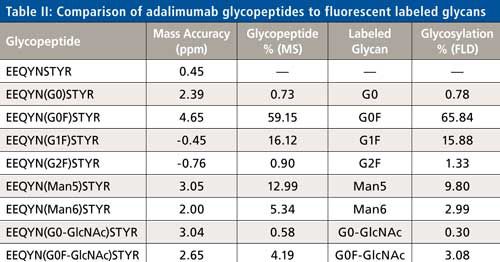
Peptide Mapping
In this section, a classical bottom-up approach using a protease digestion and LC–MS-MS for peptide mapping has been applied to adalimumab and stressed samples. Peptide mapping is at the heart of primary structural characterization of mAbs because it can be used to demonstrate sequence coverage, confirm that the expected amino acids are present in the mAb and that the amino acids are in the correct order, and demonstrate that no sequence variants are present. This is especially critical in the variable and CDR regions, which are responsible for antigen binding. Mapping the N-terminal and the C-terminal ends of the light and heavy chains using MS-MS data is also critical to demonstrate structural integrity of the mAb. This sequencing can also highlight modifications such as the formation of pyroglutamate and acetylation in the N-terminus and can be used to assess lysine clipping of the C-terminus that is often prevalent in genetically engineered antibodies. Peptide mapping provides information about PTMs that can occur such as oxidation, deamidation, phosphorylation, and glycosylation. Information as to the exact location in the sequence and the susceptibility of that site to the modification can be mined and assessed from the data.
Generally, benchmark coverage greater than 95% is anticipated and usually can be obtained from a single injection of a protease digested mAb. Often a preliminary in silico digestion using Protein Prospector or a similar on-line resource is performed to find the most efficient enzyme that will generate peptide fragments of optimal length (approximately 10–15 residues) to obtain good quality MS and MS-MS spectra. Several excellent websites are available (37–39). The predicted monoisotopic masses of the digested peptides can be used to calculate the m/z values for the various charge states that might be observed. These charge states can be used for manual searching, which is often required for the smaller peptides. Variables can include missed cleavages from a protease such as trypsin, which are common if lysine (K) or arginine (R) precedes proline (P) (40). Methionine (M) oxidation, asparagine (N) and glutamine (Q) deamidation, and phosphorylation of serine (S), threonine (T), and tyrosine (Y) can be included as possible PTMs (41–45). The final compiled information will give an inclusive picture of the anticipated peptide forms before any experimentation. Calculated m/z values aid in data mining and are useful for determining expected disulfide bridges from the nonreduced digestion (46) and for determining any scrambled disulfide linkages (47), possible trisulfide modifications (35), or thioether formation (36).
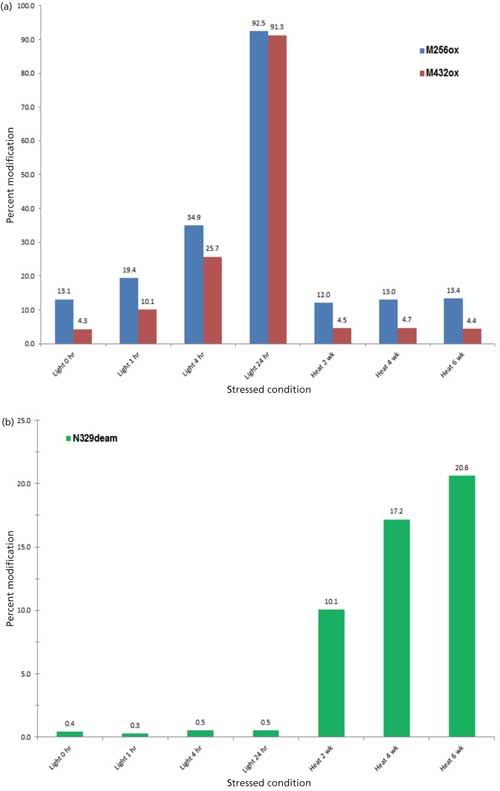
Figure 4: Effect of stressed conditions (a) on the PTMs of the oxidations of heavy chain methionine (M) 256 and 432 and (b) on the deamidation of asparagine (N) 329.
Typically, trypsin or Lys-C are the standard choices for peptide mapping of IgG mAbs and can usually provide sequence coverage of >95%. The major deficiency of using trypsin, because it cleaves on the C-terminal side of both R and K, is that it can produce very short peptides that are not retained in the chromatographic separation and are lost in the solvent front. Using Lys-C alone can produce some benefit except that sometimes excessively long peptides are produced that are difficult to elute and show marginal coverage across the MS2 spectra. During the classical protease digestion, the mAb is denatured and the disulfide bonds are usually reduced with DTT or TCEP. The free cysteines are usually alkylated with iodoacetamide or iodoacetic acid (+57 and +56 Da, respectively) to prevent crossing linking of the peptides.
A tandem approach to digesting proteins using Lys-C followed by trypsin minimizes the number of missed cleavages in both the reduced and nonreduced sample preparations making data searching and reporting simpler and less time consuming (48).
In the peptide mapping experiments described here adalimumab was first stressed under the various conditions listed below:
- Temperature at 40 °C over 6 weeks
- Exposure to white light (765 W/m2) over 48 h
- pH 9 and temperature at 40 °C
- Rapid heating to 75 °C
A sample of adalimumab stored at -80 °C was used as a control sample and compared to the stressed samples to explore the sites most susceptible to modification on the mAb.
The control sample and stressed samples were tandemly digested using Lys C and trypsin. After a rapid reversed-phase separation using UHPLC that eluted all peptides within 35 min, the peptide peaks were analyzed using scan dependent data acquisition on an orbital trap mass spectrometer.
Peptide sequence coverage and post-translation modifications were assessed using Proteome Discoverer (Thermo Scientific) software. The software used the SEQUEST algorithm to search the MS2 spectra data against a FASTA file of the theoretical amino acid sequence for adalimumab (see Figure 1). The disulfide bridges were determined in a similar manner using Peptide Finder (Thermo Scientific) software.
All preparations including the stressed samples showed greater than 95% sequence coverage. Manual searches were necessary to find the smaller peptide fragments, which were not selected by the search process. All mass accuracies for the identified peptides were less than 5 ppm.
Post-Translational Modifications
Several PTMs were observed in the stressed samples when compared to the control sample. Examples of oxidation and deamidation most readily observed in adalimumab are illustrated Figures 4a and 4b, respectively. The conditions of pH 3.0 with heat (40 °C) and heat (75 °C) did not show any significant difference from the control and were not included. It was interesting to note that when adalimumab was rapidly heated above approximately 60 °C a white precipitate, presumably the protein, began to form.
The most susceptible sites to oxidation in samples exposed to light were the methionine residues at position M256 and M432 in the heavy chain. These Lys-C digested peptides are presented by their location in the heavy chain of the mAb below: HC-L-15::(253)DTLMoxISRTPEVTCVVVDVSHEDPEVK(278) and HC-L-30::(419)SRWQQGNVFSCSVMoxHEALHNHYTQK(443).
The samples with prolonged exposure to heat (40 °C) showed an increase in asparagine deamidation at residue N329, which is located in the heavy chain of the Lys-C digested peptide: HC-L-21::(327)VSNdeamK(330).
Interestingly, all three of these modified residues fall outside the proximity of the local disulfide bridge, suggesting their positions are more exposed. Three-dimensional (3D) models of IgG1 (49) show that these regions are not located in the hydrophobic pockets formed by the alpha helices and beta sheets.
Disulfide Bridges
All predicted disulfide bridges were detected with a mass accuracy of less than 5 ppm. The light-chain portion of the hinge region was linked to a peptide showing a missed cleavage. The stressed conditions of light (765 W/m2) for 24 h and heat (75 °C) produced several scrambled disulfide bridges, which are indicated by red lines in Figure 1. It is likely that disulfide scrambling was responsible for the precipitation of adalimumab that was observed in the quickly heated stressed sample. When estimated from peak areas, both conditions showed that approximately 4% of the total disulfide population was in these rearranged configurations. The linkages suggest that the reformation process occurred quickly and that these peptide pairs lay near each other in the tertiary structure. These rearrangements distinguish the sites on the mAb most susceptible to disulfide bond scrambling.
Glycopeptides
The oligosaccharide glycosylation was observed to occur at N301 on the heavy chain as expected. The tryptic peptide location and sequence is defined by the following nomenclature: HC-T-26::(297)EEQYNSTYR(305). This peptide sequence, because it is in the constant region, actually transcends intact into other IgG1 mAbs; however, the position varies because of sequence differences between IgG1 mAbs in the variable region. The mass analysis of the scFC domain (see Figure 3) and the N-linked glycan profiling discussed below aided in identifying and finding these glycopeptides. The reversed-phase chromatogram showed that these glycopeptides were eluted in close proximity and were not significantly resolved. Identification was confirmed by mass accuracies of less than <5 ppm using the high-resolution mass spectrometer. A comparison of percent glycosylation determined from the MS analysis of the glycopeptides and those observed using the tagging and HILIC separation with fluorescence detection is shown in Table II.
The glycopeptides gave more meaningful MS-MS spectral information than their tagged glycan counterparts; however, the parent mass signal was relatively small in comparison. The weakness of CID to generate b and y peptide backbone ions prevents localization of the glycan. The use of MS techniques such as ETD (47) and enrichment of the peptide glycans are known to produce better information concerning the peptide backbone and location of the glycopeptide.
Profiling of N-Linked Glycans
Glycosylation is one of the most important PTMs of proteins and plays an essential role in various biological processes. Hence, glycosylation of therapeutic antibodies is a critical quality attribute that needs to be monitored during manufacturing and stability studies (50). With the advancement of MS technologies glycosylation analysis is possible at various levels of the protein molecule (top-down and middle-down proteomics) and glycosylation analyses (51), at glycopeptide level (glycoproteomics), (52), or analyzing released glycans (glycomics) (53). The current generation of tandem mass spectrometers offer multiple fragmentation options (CID, HCD, ETD) that all can be used in glycan analysis and offer complementary information if used at either the glycopeptide or glycan level (54,55).
While technology enables the collection of high-quality and complex fragmentation data on glycans, the existing bioinformatics technology is lagging behind because of the vast heterogeneity of glycans in terms of structures and linkages as well as the limitations of current glycomics databases (56–58). Despite the limitations, glycan de novo sequencing is a rapidly evolving field (59).
Separation and quantitation of glycans is usually accomplished after fluorescence derivatization using HILIC and UHPLC frequently coupled to MS detection. Fluorescence and MS detection provide complementary data: MS and MS-MS analysis can provide composition and sequence data; however, samples containing isomeric and isobaric glycan structures might not be distinguished unambiguously. However, LC with fluorescence detection coupled to electrospray ionization (ESI) can greatly improve glycan analysis by linking compositional identification to elution order in complex glycan samples and save in the procurement of costly glycan reference standards. Additionally, the sensitivity, stoichiometry, robustness, and linearity of fluorescent labeling approaches offer femtomole detection and accurate quantitation of labeled glycans.
Another emerging technology, ion mobility spectrometry (IMS) coupled to mass spectrometry, offers another dimension in separation based on both the size and shape of the molecule. This technique offers exciting new possibilities combining separation and detailed characterization including 3D shape information (60).
N-Linked Glycan Analysis of Adalimumab
Recently Lauber and colleagues (6) introduced a new fluorescent label that has both an active fluorophore and an attached tertiary amine that provides strong responses using fluorescence and MS detection. The technique greatly improves the speed and efficiency of the sample preparation. Here the N-glycan profiling of adalimumab using a fluorescent label was performed and the HILIC separation resulted in a well-resolved chromatogram of glycan species in approximately 1 h. Based on MS and MS-MS analysis, 22 species of glycans were successfully identified. Relative abundances were determined based on fluorescence chromatograms. Total ion current (TIC) chromatograms were observed to closely match the fluorescence chromatograms indicating the simultaneous high fluorescence response and MS response of the fluorescent label. High labeling efficiency was also demonstrated by the absence of unlabeled glycan peaks in the TIC chromatograms. The FLD chromatogram and the corresponding TIC chromatogram of the N-linked glycans of adalimumab are presented in Figure 5. The relative abundances for these glycans are summarized in Table III. Even trace amounts of glycans less than 0.05% were successfully detected in both the fluorescence and total ion current chromatograms. The TIC chromatograms were free of the presence of unlabeled glycan species that are often observed when using other fluorescent labels.
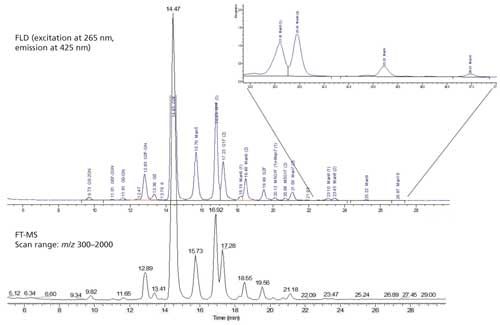
Figure 5: Example FLD and TIC chromatograms of HILIC separation of N-linked glycans for adalimumab.
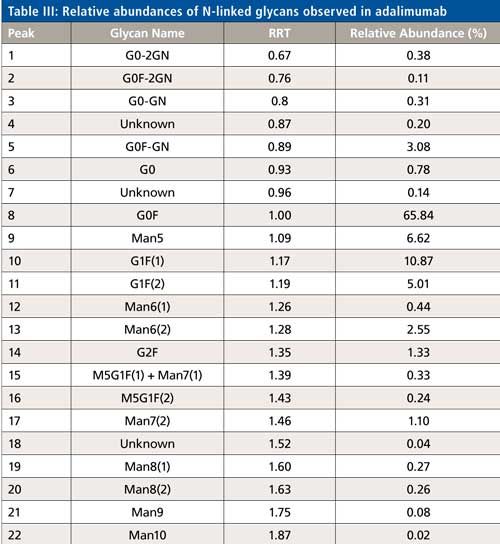
Labeled glycan species were generally detected as single or double charges and in some cases as sodium adducts (+23 Da). Although glycans are known to ionize poorly, the fluorescent label tagging increased electrospray ionization efficiency and subsequently MS response because of the tertiary amine group attached to the fluorescent label. Masses of intact glycans were detected with high confidence and allowed confirmation of the glycans by accurate mass measurement. The MS2 spectrum and associated structures of the daughter ions are shown in Figure 6 for G0F, which was the most abundant N-linked glycan found in adalimumab.
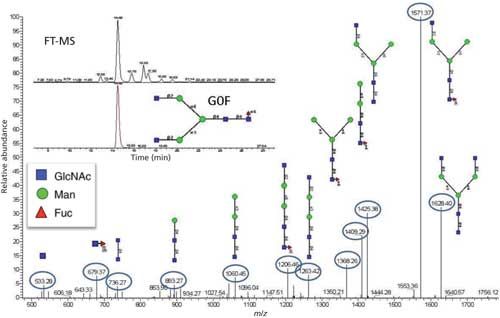
Figure 6: Example MS2 spectrum of N-linked glycan G0F after CID.
The major glycan species found here match the results of the middle down approach observed in Figure 3 and in Table I and also at the glycopeptide level (see Table II). All corresponding heavy chain or heavy chain glycopeptides that carry a glycan modification having >5% relative abundance were confirmed and quantitated accordingly in agreement with these independent glycoprofiling analyses.
Interestingly, the analysis of stressed samples revealed no observable change in glycan composition or abundance compared to the control sample regardless of the stress conditions.
Conclusion
The major applications of electrospray MS to the characterization of monoclonal antibodies and associated large proteins have been highlighted. This discussion has included applications of top-down, middle-down, middle-up, and the classical bottom-up approaches using MS. Data showing the utility of approaching the molecular characterization of monoclonal antibodies, in particular, adalimumab, from several directions has been presented and discussed. Intact mass and partial digestion followed by mass analysis using high-resolution MS has displayed the dissemination of information with regard to determining whole-molecule and larger component traits. It has been shown to be integral to the measurement of the various degrees of glycosylation and the isoforms of the mAb. The N-linked glycan measurements add fine detail to mass analysis of the larger mAb structures and peptide mapping experiments. The glycan profiling compliments the whole mass work by adding clarity to the relative amounts and types of glycan isoforms of which the molecule is composed. Peptide mapping, post-translational modifications, and disulfide bond inquiries help to fill in the multitude of details necessary to understand the complexity of mAbs and resolve their structure and behavior under normal and stressed conditions as completely as possible. As has been demonstrated in this discussion, MS has played and will continue to play a central role in the structural characterization of the monoclonal antibodies as scientists continue to strive to increase their knowledge of these large and complex biomolecules.
References
- J.M. Reichert, mAbs4, 413–415 (2015).
- L.M. Jarvis, Chem. Eng. News94, 14–17 (2016).
- A.M. Thayer, Chem. Eng. News93, 28–29 (2015).
- R.G. Hamilton, The Human IgG Subclasses (Calbiochem-Noviachem Corporation, 2001).
- J.R. Wisniewski, A. Zougman, N. Nagaraj, and M. Mann, Nat. Methods6, 359–362 (2009).
- M.A. Lauber, D.W. Brousmiche, Z. Hua, S.M. Koza, E. Guthrie, P. Magnelli, C.H. Taron, and K.J. Fountain, Waters Application Note 720005275EN (2015).
- M.A. Lauber, Y.Q. Yu, D.W. Brousmiche, Z. Hua, S.M. Koza, P. Magnelli, E. Guthrie, C.H. Taron, and K.J. Fountain, Anal. Chem. 87, 5401–5409 (2015).
- D. Ren , G.D. Pipes, D. Liu, L.Y. Shih, A.C. Nichols, M.J. Treuheit, D.N. Brems, and P.V. Bondarenko, Anal. Biochem. 392, 12–21 (2009).
- O.V. Krokhin, M. Antonovici, W. Ens, J.A. Wilkins, and K.G. Standing, Anal. Chem.78, 6645–6650 (2006).
- P. Hao, Y. Ren, A. Datta, J.P. Tam, and S.K. Sze, J. Proteome Res.14, 1308–1314 (2015).
- J.M. Froelich and G.E. Reid, Proteomics8, 1334–1345 (2008).
- J.E. Syka, J.J. Coon, M.J. Schroeder, J. Shabanowitz, and D.F. Hunt, Proc. Natl. Acad. Sci. U.S.A. 9528–9533 (2004).
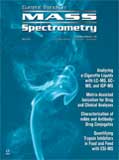
Evaluating the Accuracy of Mass Spectrometry Spectral Databases
May 12th 2025Mass spectrometry (MS) can be effective in identifying unknown compounds, though this can be complicated if spectra is outside of known databases. Researchers aimed to test MS databases using electron–ionization (EI)–MS.
New Method Explored for the Detection of CECs in Crops Irrigated with Contaminated Water
April 30th 2025This new study presents a validated QuEChERS–LC-MS/MS method for detecting eight persistent, mobile, and toxic substances in escarole, tomatoes, and tomato leaves irrigated with contaminated water.

.png&w=3840&q=75)

.png&w=3840&q=75)



.png&w=3840&q=75)



.png&w=3840&q=75)











